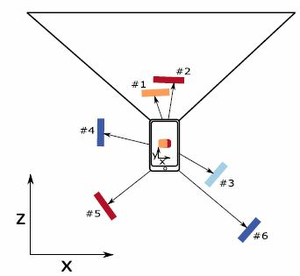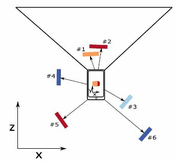Information
- Publication Type: Master Thesis
- Workgroup(s)/Project(s):
- Date: November 2020
- Date (Start): 12. February 2020
- Date (End): 18. November 2020
- TU Wien Library:
- Second Supervisor: Hsiang-Yun Wu
- Diploma Examination: 18. November 2020
- Open Access: yes
- First Supervisor: Eduard Gröller
Abstract
Route planning is a common task that often requires additional information on Points-of-Interest (POIs). Augmented Reality (AR) enables mobile users to explore text labels and provides a composite view associated with additional information in a real-world environment. Displaying all labels for Points-of-Interest on a mobile device will lead to unwanted overlaps, and thus a context-responsive strategy to properly arrange labels is expected. This framework should consider removing overlaps, the correct Level-of-Detail to be presented, and also label coherence. This is necessary as the viewing angle in an AR system may change frequently due to users’ behaviors. The consistency of labels plays an essential role in retaining user experience and knowledge, as well as avoiding motion sickness. In this thesis, we aim to develop an approach that systematically manages label visibility and Levels-of-Detail, as well as eliminates unexpected incoherent label movement. To achieve this, we introduce three label management strategies, including (1) Occlusion Management, (2) Level-of-Detail Management, and (3) Coherence Management. A greedy approach is developed for fast occlusion handling. A Level-of-Detail scheme is adopted to arrange various types of labels in AR. A 3D scene manipulation is built to simultaneously suppress the incoherent behaviors induced by the changes of viewing angles. Finally, we present our approach’s feasibility and applicability by demonstrating one synthetic and two real-world scenarios, followed by a qualitative user study.Additional Files and Images
Weblinks
BibTeX
@mastersthesis{Koeppel2020,
title = "Context-Responsive Labeling in Augmented Reality",
author = "Thomas K\"{o}ppel",
year = "2020",
abstract = "Route planning is a common task that often requires
additional information on Points-of-Interest (POIs).
Augmented Reality (AR) enables mobile users to explore text
labels and provides a composite view associated with
additional information in a real-world environment.
Displaying all labels for Points-of-Interest on a mobile
device will lead to unwanted overlaps, and thus a
context-responsive strategy to properly arrange labels is
expected. This framework should consider removing overlaps,
the correct Level-of-Detail to be presented, and also label
coherence. This is necessary as the viewing angle in an AR
system may change frequently due to users’ behaviors. The
consistency of labels plays an essential role in retaining
user experience and knowledge, as well as avoiding motion
sickness. In this thesis, we aim to develop an approach that
systematically manages label visibility and
Levels-of-Detail, as well as eliminates unexpected
incoherent label movement. To achieve this, we introduce
three label management strategies, including (1) Occlusion
Management, (2) Level-of-Detail Management, and (3)
Coherence Management. A greedy approach is developed for
fast occlusion handling. A Level-of-Detail scheme is adopted
to arrange various types of labels in AR. A 3D scene
manipulation is built to simultaneously suppress the
incoherent behaviors induced by the changes of viewing
angles. Finally, we present our approach’s feasibility and
applicability by demonstrating one synthetic and two
real-world scenarios, followed by a qualitative user study.",
month = nov,
address = "Favoritenstrasse 9-11/E193-02, A-1040 Vienna, Austria",
school = "Research Unit of Computer Graphics, Institute of Visual
Computing and Human-Centered Technology, Faculty of
Informatics, TU Wien",
URL = "https://www.cg.tuwien.ac.at/research/publications/2020/Koeppel2020/",
}

 Image
Image Master Thesis
Master Thesis Poster
Poster


